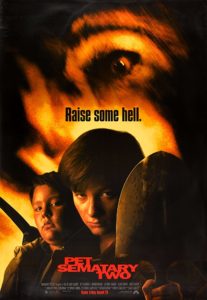
THE GROUND IS SOUR
Like some abominable distortion of animal or man rising from the Micmac Burial Ground, Pet Sematary Two is a horror sequel that refuses to stay down.
Is it great? Not at all. It’s reckless at best, and careless at worst.
But that doesn’t mean there wasn’t a certain amount of potential in its story of the residents of Ludlow, Maine, and an intermittent sense of craftsmanship to the whole thing.
During a recent re-watch of Two, I found myself pondering the circumstances that inspired Paramount to bankroll a sequel to Mary Lambert’s 1989 original (based off Stephen King’s novel, and adapted for the screen by the author).
PET SEMATARY TWO APPROACHES…
The tonal difference between the two films is evident in the poster art: Pet Sematary has the classic monochromatic image of Victor Pascow’s (Brad Greenquist) blood-dripping skull and glaring eye, with gray housecat Church wandering among grave markers. The chilling tag line? “Sometimes Dead is Better.”
Contrast that to Pet Sematary Two, which has the silhouetted image of teens on bikes among grave markers, caught within the distorted image of a white dog, one beady eye staring the viewer down. The “Back by Popular Demand” tag line on the theatrical poster is rather inexplicable, given the three-year lull between films. The video art, however, conveys its intentions with greater accuracy: “Raise Some Hell.”
Whereas the 1989 film carried a “Monkey’s Paw” theme of being careful what you wish for (and thereby creating a genuine sense of foreboding), and ended on a potent note of men not learning from their mistakes, the sequel barrels forward into bad decision after bad decision, with gruesome results rendered in the most extravagant manner possible. The relative restraint of the original – grounded by King’s sensitive and thoughtful screenplay – is replaced with overachieving violence and an uneven tone.
I’ll give Two some credit: it alludes to the fate of Ellie Creed, reproduces key locations from the first film (the titular animal graveyard; the deadfall; the Indian burial ground), and adheres to the “rules” King established in the novel (“you bury your own”). And, of all the cast members, Clancy Brown’s sociopath Sheriff Gus Gilbert is the only character to attempt one of King’s patented Maine accents (which makes it all the more jarring when no one else does).
While Lambert’s original film centered around the destruction of the family unit in tragic fashion, Pet Sematary Two uses a tragedy as its catalyst until about the halfway point, after which it tumbles into excess and campiness. The longer it goes on, the further it strays from any sort of grounded emotional center, to the point where its closing minutes try – and ultimately fail – to latch onto a trippy dream-logic.
The climax could be read as an extreme manifestation of grief felt by Jeff (Edward Furlong, fresh off a more high-profile sequel), whose actress mother Renee (Darlaane Fluegel) died on a movie set, but this notion is threaded unevenly throughout the film, making for an unsatisfying payoff.
SHIFTING PERSPECTIVES
Where Pet Sematary Two succeeds in justifying its existence – for a little while, at least – is in changing the perspective of horror from the eyes of grownups to the eyes of children. As someone who lost a parent before hitting twenty, it’s a confusing and frustrating batch of emotions to sort through, especially when so many Real World machinations have yet to fully cohere in the teenage mind.
We don’t get a lot of time with Jeff and Renee, but the opening minutes establish their relationship in a rudimentary way; they clearly have great affection for each other. Jeff’s ensuing move back to Ludlow with father Chase (Anthony Edwards), however, carries a sense of friction. Furlong broods like a champ, with Lambert riffing on the iconic images of Malcolm McDowell and Jack Nicholson doing likewise in A Clockwork Orange and The Shining, respectively. Meanwhile, Edwards hits the proper beats as a veterinarian struggling with his son’s rebellion and his own grief.
As seen through the eyes of Jeff and Drew (Jason McGuire), the growing pains of adolescence – including some distinctly Kingsian bullies – are underlined by gray areas of youthful arrogance and the unknowable mysteries of human existence. Drew, stepson to the abusive Gus, must contend with the murder of his dog at the hands of his hotheaded stepfather. In addition to being the put-upon “fat kid,” Drew possesses a sullen passivity – as if resigned to his lot in life, and the notion that things will never get better – to the point where resurrecting his dog (with the truly awful name, “Zowie”) becomes just another phase of the mourning ritual.
Unlike the ostensibly wise adults in the 1989 film, the kids’ actions here are more excusable, as they don’t truly comprehend the power of what they’re dealing with. Instead of onanism, these boys are using adolescence to experiment with life and death.
Up until the point of Zowie’s return, Lambert and writer Richard Outten do a decent job of building the characters and themes of this new chapter, and the small-town locations carry all the aesthetic hallmarks of King’s fiction.
To Be Continued…
The Plot Sickens: Check out Jonny Numb’s report on the theatrical re-release of Suspiria!
(Still photo of Clancy Brown in Pet Sematary Two via Villains Fanon Wiki.)
Crash Analysis Support Team
 Jonny Numb
Jonny Numb
(Aka Jonathan Weidler) has experienced enough pet and human death to justify several volumes of Pet Sematary fan fiction. He co-hosts THE LAST KNOCK horror podcast on iTunes, and can be found on Twitter and Letterboxd @JonnyNumb. In addition to Crash Palace Productions, he also contributes to Loud Green Bird.

